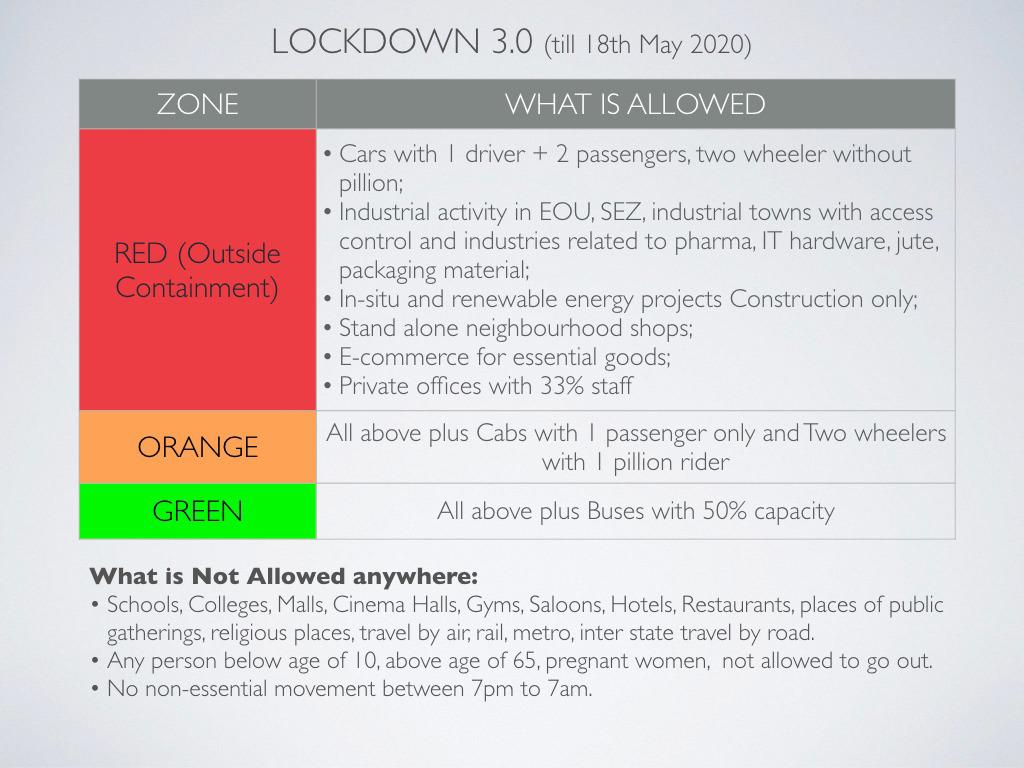The Ministry of Home Affairs on Friday announced an extension of two weeks to the nationwide lockdown which was first declared by Prime Minister Narendra Modi on March 24.
The Lockdown 3.0, however, will not be as restrictive as its previous versions. As per the MHA statement, the strictness of the extended lockdown will depend on the level of Covid-19 outbreak in the respective districts.
The Green Zones are the districts with either zero confirmed cases till date; or, no confirmed case in the last 21 days.
The Red Zones are classified on the basis of the total number of active cases, doubling rate of confirmed cases, the extent of testing and surveillance feedback from the districts.
Those districts, which are neither defined as Red nor Green, are classified as Orange zones.
The MHA had earlier issued a list of current zine-wise listing of the districts across the country. This list will be updated every week.
Since India is trying to exit the lockdown in a graded manner, Lockdown 3.0 - which will be in place from May 4- allows various activities in all zones.
What's openin Lockdown 3.0:
Red Zones
A large number of other activities are allowed in the Red Zones.
All industrial and construction activities in rural areas, including MNREGA works,food-processing units and brick-kilns are permitted; besides, in rural areas,without distinction to the nature of goods, all shops, except in shopping malls are permitted.
Allagriculture activities, e.g., sowing, harvesting, procurement and marketing operations in the agricultural supply chain are permitted.
Animal husbandry activities are fully permitted, including inland and marine fisheries.
All plantation activities are allowed, including their processing and marketing.
All health services (including AYUSH) are to remain functional, including transport of medical personnel and patients through air ambulances.
A large part of the financial sector remains open, which includes banks, non-banking finance companies (NBFCs), insurance and capital market activities, and credit co-operative societies.
Operation ofhomes for children, senior citizens, destitutes, women and widows etc.; and operation of Anganwadis has also been permitted.
Publicutilities, e.g., utilities in power, water, sanitation, waste management,telecommunications and internet will remain open, and courier and postal services will be allowed to operate.
Most of thecommercial and private establishments have been allowed in the Red Zones. Theseinclude print and electronic media, IT and IT enabled services, data and callcentres, cold storage and warehousing services, private security and facilitymanagement services, and services provided by self-employed persons, except forbarbers etc.
Manufacturingunits of essential goods, including drugs, pharmaceuticals, medical devices,their raw material and intermediates; production units, which requirecontinuous process, and their supply chain; Jute industry with staggered shifts and social distancing; and manufacturing of IT hardware and manufacturing unitsof packaging material will continue to be permitted.
Orange Zones
In the OrangeZones, in addition to activities permitted in Red Zone, taxis and cabaggregators will be permitted with 1 driver and 1 passenger only.
Inter-districtmovement of individuals and vehicles will be allowed for permitted activitiesonly. Four wheeler vehicles will have maximum two passengers besides the driverand pillion riding will be allowed on two-wheelers.
Green Zones
In the GreenZones, all activities are permitted except the limited number of activitiesthat are prohibited throughout the country, irrespective of the zone. However,buses can operate with upto 50 per cent seating capacity and bus depots canoperate with upto 50 per cent capacity.
All goodstraffic is to be permitted. No State/ UT shall stop the movement of cargo forcross land-border trade under Treaties with neighbouring countries. No separatepass of any sort is needed for such movement, which is essential formaintaining the supply chain of goods and services across the country duringthe lockdown period.
Additionally,the Centre has also allowed e-commerce websites to deliver non-essential itemsin orange and green zones.
All otheractivities, which are not specifically prohibited, will be permittedactivities.
However,states/ UTs, based on their assessment of the situation, and with the primaryobjective of keeping the spread of Covid-19 in check, may allow only selectactivities from out of the permitted activities, with such restrictions as feltnecessary.
What's closedin Lockdown 3.0
Apart fromzone-wise restriction, there is a limited number of activities that will remainprohibited throughout the country, irrespective of zones
These includetravel by air, rail, metro and inter-state movement by the road.
Running ofschool, college, institutions, hospitality services, including hotels andrestaurants, place of large gathering, such as cinema halls, malls, gym, sportscomplex, social, political, cultural and all kind of gathering, religiousplace/ place of worship for public will continue to remain banned during thelockdown.
Leave a comment
Your email address will not be published. Required fields are marked *


